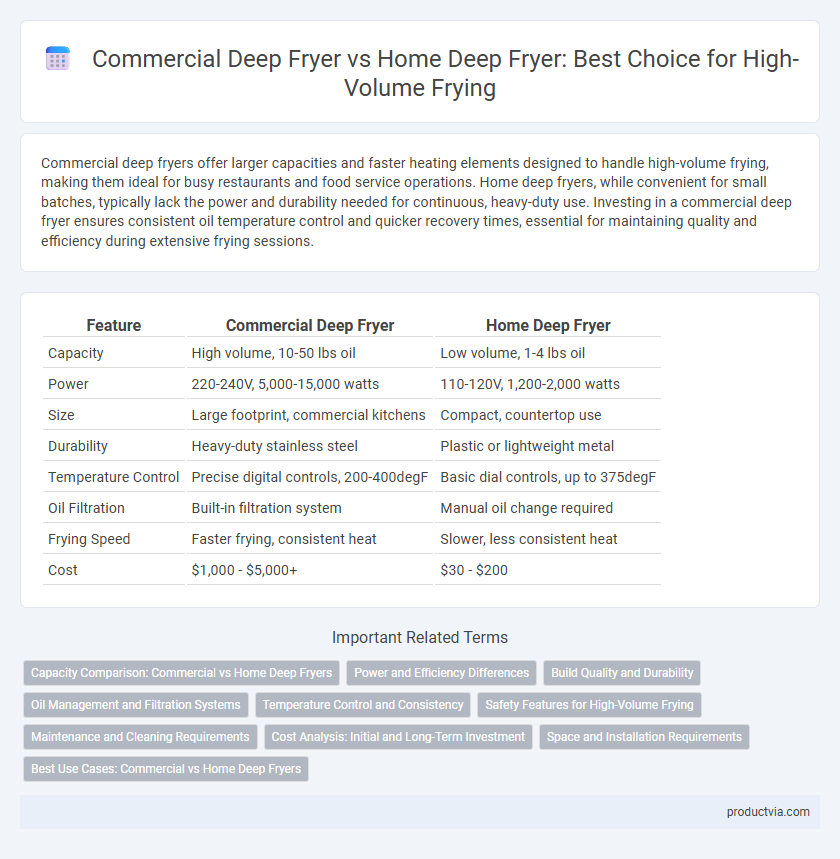Commercial deep fryers offer larger capacities and faster heating elements designed to handle high-volume frying, making them ideal for busy restaurants and food service operations. Home deep fryers, while convenient for small batches, typically lack the power and durability needed for continuous, heavy-duty use. Investing in a commercial deep fryer ensures consistent oil temperature control and quicker recovery times, essential for maintaining quality and efficiency during extensive frying sessions.
Table of Comparison
| Feature | Commercial Deep Fryer | Home Deep Fryer |
|---|---|---|
| Capacity | High volume, 10-50 lbs oil | Low volume, 1-4 lbs oil |
| Power | 220-240V, 5,000-15,000 watts | 110-120V, 1,200-2,000 watts |
| Size | Large footprint, commercial kitchens | Compact, countertop use |
| Durability | Heavy-duty stainless steel | Plastic or lightweight metal |
| Temperature Control | Precise digital controls, 200-400degF | Basic dial controls, up to 375degF |
| Oil Filtration | Built-in filtration system | Manual oil change required |
| Frying Speed | Faster frying, consistent heat | Slower, less consistent heat |
| Cost | $1,000 - $5,000+ | $30 - $200 |
Capacity Comparison: Commercial vs Home Deep Fryers
Commercial deep fryers offer significantly larger oil capacities, typically ranging from 30 to 100 liters, enabling them to handle high-volume frying efficiently in restaurant settings. Home deep fryers usually hold between 1 to 5 liters of oil, designed for smaller batches suitable for personal or family use. The substantial capacity difference allows commercial units to maintain consistent cooking temperatures and fry larger quantities without frequent oil changes, crucial for sustained output.
Power and Efficiency Differences
Commercial deep fryers offer significantly higher power output, typically ranging from 15,000 to 30,000 BTUs, compared to home deep fryers which usually have 1,800 to 3,000 watts, enabling faster oil temperature recovery and consistent cooking for high-volume frying. The larger heating elements and advanced thermostatic controls in commercial models ensure greater efficiency by maintaining stable oil temperatures, reducing cook times and oil absorption. In contrast, home deep fryers are designed for smaller batches, leading to longer heat recovery periods and less efficient energy use in high-volume frying scenarios.
Build Quality and Durability
Commercial deep fryers feature heavy-duty stainless steel construction and industrial-grade heating elements designed to withstand continuous, high-volume frying demands. Home deep fryers typically use lighter materials and lower-capacity components, making them less durable for prolonged commercial use. The superior build quality of commercial fryers ensures enhanced durability, consistent performance, and easier maintenance in busy kitchen environments.
Oil Management and Filtration Systems
Commercial deep fryers feature advanced oil management and filtration systems designed for continuous high-volume frying, extending oil life and maintaining consistent food quality. Home deep fryers typically have limited filtration capabilities, requiring more frequent oil changes and manual cleaning to prevent oil degradation. Efficient oil filtration in commercial models reduces waste and operational costs, making them ideal for restaurant environments with heavy frying demands.
Temperature Control and Consistency
Commercial deep fryers offer precise temperature control systems with powerful thermostats that maintain consistent heat during continuous high-volume frying, ensuring uniform cooking results and reducing oil degradation. Home deep fryers typically have less accurate sensors and smaller heating elements, leading to fluctuations in temperature that can affect food quality and frying efficiency. For businesses requiring consistent batch cooking and oil longevity, commercial models deliver superior performance with advanced temperature regulation technology.
Safety Features for High-Volume Frying
Commercial deep fryers incorporate advanced safety features such as automatic shut-off systems, high-temperature limiters, and heavy-duty thermostats designed to handle continuous high-volume frying demands. These units often include splash guards and secure locking lids to minimize oil spills and burns, reducing workplace accidents in busy kitchens. Home deep fryers typically lack such robust safeguards, making commercial models essential for maintaining safety in environments with frequent, large-scale frying operations.
Maintenance and Cleaning Requirements
Commercial deep fryers feature stainless steel construction and advanced filtration systems designed to withstand high-volume frying demands, facilitating easier cleaning and reducing oil degradation. Home deep fryers, typically smaller with plastic components, require more frequent oil changes and manual cleaning, making maintenance more labor-intensive when used for large batches. Efficient maintenance in commercial units minimizes downtime, ensuring consistent cooking performance and extending equipment lifespan.
Cost Analysis: Initial and Long-Term Investment
Commercial deep fryers require a significantly higher initial investment, often ranging from $1,000 to $5,000, compared to home deep fryers priced between $50 and $200. The long-term costs of commercial units include higher energy consumption, regular maintenance, and the need for durable parts designed to withstand continuous use. Home deep fryers, while cheaper upfront, may incur replacement costs sooner due to less robust construction and are less efficient for high-volume frying demands.
Space and Installation Requirements
Commercial deep fryers demand significantly more space and professional installation due to their larger capacity and specialized ventilation systems, making them suitable for high-volume frying in restaurant kitchens. Home deep fryers are compact and designed for countertop use, requiring minimal space and simple plug-in installation ideal for smaller-scale cooking. The difference in space and setup complexity directly affects their suitability for continuous, high-volume frying operations.
Best Use Cases: Commercial vs Home Deep Fryers
Commercial deep fryers are designed for high-volume frying with larger oil capacities, faster heat recovery, and robust construction suited for continuous use in restaurants and food service establishments. Home deep fryers typically have smaller capacities, slower heat recovery, and are ideal for occasional frying, making them unsuitable for the high demands of commercial kitchens. For best use cases, commercial fryers excel in efficiency and durability for busy environments, while home fryers provide convenience and ease for personal or small-scale frying needs.
Commercial deep fryer vs Home deep fryer for high-volume frying Infographic

 productvia.com
productvia.com